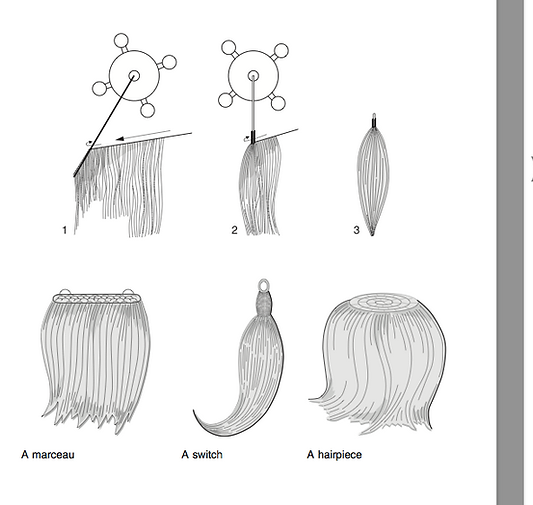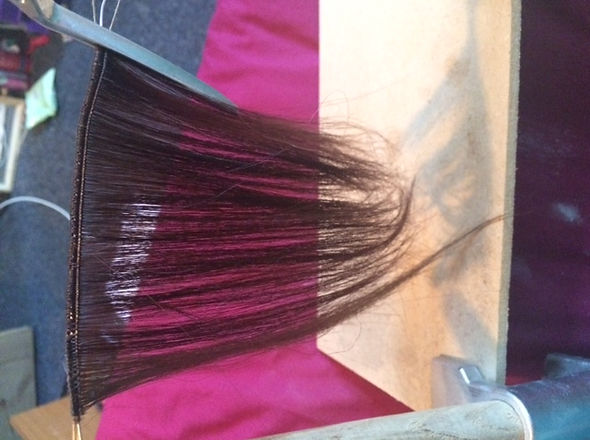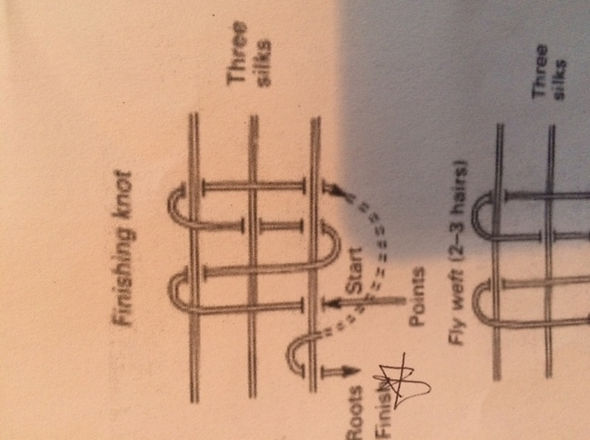

Wire Wefts
When weaving hair, the amount of hair you use varies for what you're making. Eyelashes use 1 hair because any more would look incorrect and would also be too heavy.
You can use 6-8 hairs at a time for wire hair wefts, which is called 'bulk weaving', and 3-6 for a switch.
Another difference between wire wefts and eyelashes is that a hair weft is made on 2 strings and a wire, whereas an eyelash is made with just two strings.
If you were to make a circular hair piece for the crown, you could either knot it or make a weft. If lace was used as a base, it could potentially rip (as it would be attatched to hair, not skin), so instead, foundation lace would be used. You would whip around the edge of it and then start knotting.
Creating this effect with a weft is quicker than knotting it. A 3-string weft is very floppy, even when sewn into shape. This is why one of the strings is replaced with wire. The wire also helps the piece to fit to the shape of the head better.
Honeycomb mesh is used to make a chignon. Diamond mesh can also be used, but its more typically used for fantasy/historical work.
Required Equipment:
- Black strong sewing thread
- Weaving silk. This comes in 4 coloursand is used for the majority of weft work. Its made of 3-ply threads and lightly covered with beeswax which makes it shiny. It also helps the hair stay in place as its slightly tacky.
- 0.7mil wire (from Banbury). You cannot use wire which will rust when washing the hair pieces (copper covered with tin works). You also wouldn't want the hair to discolour.
- Haircombs or hair extension slips to insert hair piece into the hair
- Soft block
Method:
- Cover the block with cellophane and tape an area big enough to draw on the template
- Find a circular object to draw around for a perfect circle. It should be the same size as the template.
- Draw around this with a sharpie
- Depending on how big you want the weft to be, you then draw one or two circles equidistant inside the first circle. you then draw 'petals' inside of these circles. Sellotape over design
- Remove from black and cut around template
- Using pins, measure how much weft you'll need using string, then measyre the length of the string
- Pin the string into the block when measuring, starting in the middle. Follow the design and don;t cut corners or you wont measure the correct amount of weft needed.
- The outer circumference will be done in a different weft, so 2 measurements need to be taken.
- Weaving clamps are shoulder width apart and you work from right to left. Add 40/50cm onto your original length so that you won't run out or you won't be able to finish the weave.
- Make a kitten toy with paper and the end of your thread, Tie the lengths of thread to the top and bottom of the stick so the wire can go in the middle.
- WIND THEM AROUND THE STICK THE SAME WAY so that they end up turning towards you.
- Tie the strings at the ends with 2 knots so that they stay around the pin.
- For the wire, measure it the same length as the thread. Don't make a kitten toy as it wont work, just twist it around the stick. For the other end just wrap it a few times around the nail
- put a pincurl clip at the tail end when weaving to help keep the hairs in place and always weave about 2cm more than you'll need (just in case).
- You start by doing the outer circumference of the template and weave a flat weft. When you get to the mark that signals you've reached the inner circumference, start wig wefting.
TO FINISH:
- Cut thread with enough left to tie a finishing knot. Clip the wire
- Remove from the other end
- Turn wire flat against the weft.
- Use a needle and thread around the wire to cover it
For attatching it to foundation lace, you mould and twist it to the shape.
These sheets show the different kinds of wefting, and how to attatch a weft to the foundation when its finished.








My template
Example of how it should look


I tried to find some tutorials regarding how to attatch these kind of hairpieces, or a tutorial on how to create wire weft hair pieces, but I couldn't find anything. There were tutorials on mkaing wefts with strings, but none with wire.
Musgrove, J. Make-Up, Hair and Costume for Film and Television (2002) UK: Focal Press


I actually got quite a lot of my hair weft successfully weaved, although I didn't quite manage to finish it.
© 2023 by Tennis Lessons with Karen. Proudly created with Wix.com